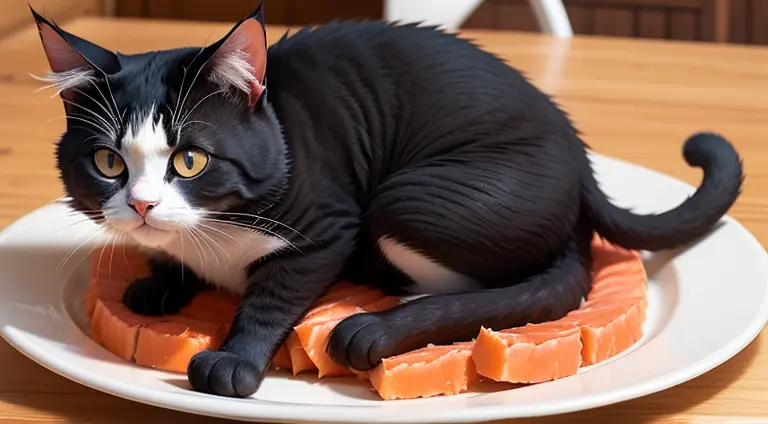It’s important, however, to ensure that these treats are safe and healthy for our feline friends. One common question that pet owners ask is whether cats can eat imitation crab. In this article, we’ll explore the ins and outs of this popular seafood substitute and whether it’s suitable for your cat.
What is Imitation Crab?
Imitation crab, often labeled as “surimi,” is a seafood substitute made from various fish, starches, and flavorings. It’s designed to mimic the taste and texture of real crab meat. The primary ingredients in imitation crab include white fish (such as pollock or cod), starches, sugar, and artificial flavorings.
Explanation of imitation crab
Imitation crab, also known as “surimi,” is a popular seafood substitute that mimics the flavor and texture of real crab meat. However, it’s important to note that imitation crab is not actually crab at all.
To give imitation crab its crab-like taste, artificial flavors and seasonings are added. Additionally, starches like wheat or tapioca are used as binders to create the desired texture. Sugar and other ingredients may also be included for taste enhancement.
It’s important to understand that while imitation crab provides a cost-effective alternative to real crab, it lacks the nutritional value and natural flavor of genuine seafood. Therefore, when considering its use in recipes or as a dietary choice, it’s essential to be aware of its composition and limitations.
You can also read about :Can Cats Eat Rice Cakes
Can Cats Eat Imitation Crab?
While cats are obligate carnivores and have specific dietary needs, they can technically eat small amounts of imitation crab. However, there are some important considerations to keep in mind:

General Considerations:
- Cats’ Dietary Needs: Cats require a diet rich in animal-based proteins, and imitation crab is not a suitable source of these essential nutrients.
- Potential Allergens: Some cats may be allergic to certain ingredients in imitation crab, leading to adverse reactions.
Nutritional Content of Imitation Crab:
- Fat: It may contain unhealthy fats, which can contribute to obesity in cats.
- Carbohydrates: Imitation crab often contains starchy fillers that are not beneficial for cats.
Risks Associated with Feeding Cats Imitation Crab:
- Sodium Content: Imitation crab is often high in sodium, which can be harmful to your cat’s health if consumed in excess.
- Artificial Additives: It may contain artificial flavors, colors, and preservatives that are not ideal for your cat’s well-being.
- Allergic Reactions: Some cats may experience allergic reactions, including gastrointestinal upset or skin issues, after consuming imitation crab.
Health Implications:
Feeding your cat imitation crab on a regular basis can have health implications. Cats may experience digestive problems and, if consumed excessively, may gain weight, leading to obesity-related health issues.
Impact on Cat’s Health: Considerations
- Digestive Health: Cats have sensitive digestive systems, and introducing unfamiliar or unsuitable foods can lead to gastrointestinal upset. It’s essential to monitor your cat for signs of diarrhea, vomiting, or discomfort after trying new foods.
- Weight Management: Feeding your cat foods that are high in unhealthy fats or carbohydrates, such as imitation crab, can contribute to weight gain. Obesity in cats can lead to various health issues, including diabetes and joint problems.
- Allergic Reactions: Cats can develop allergies to specific ingredients in their diet. It’s crucial to watch for signs of allergies, like itching, skin problems, or digestive issues, and eliminate the allergen from their diet promptly.
- Nutritional Deficiencies: Imitation crab lacks the essential nutrients that cats need to thrive, such as taurine, which is crucial for heart and eye health. Feeding it regularly may result in nutritional deficiencies over time.
- Dental Health: Some treats, including those with a high sugar content, can contribute to dental problems in cats. Dental health is a critical aspect of overall well-being, and you should prioritize cat-friendly dental care options.
Safe Ways to Offer Imitation Crab to Cats:
If you decide to offer your cat a small amount of imitation crab as an occasional treat, follow these guidelines:
- Preparation Guidelines: Ensure that the imitation crab is fresh and free from any additives or seasonings.
- Portion Control: Limit the amount to a small piece, as a little goes a long way for cats.
- Observing Your Cat’s Reactions: Watch for any adverse reactions, and discontinue feeding imitation crab if your cat shows any signs of discomfort or allergies.
Conclusion:
As responsible pet owners, it’s essential to prioritize your cat’s health and provide them with a well-balanced, species-appropriate diet. If you want to treat your feline friend, consider alternatives like cat-specific treats designed to meet their nutritional needs and ensure their well-being.
Certainly, here are five frequently asked questions (FAQs) related to cats and their care:
1. What should I feed my cat, and how much?
- Cats require a balanced diet rich in animal-based proteins. Commercial cat food provides the necessary nutrients. Consult with your veterinarian to determine the right portion size based on your cat’s age, weight, and activity level.
2. How can I prevent my cat from scratching furniture?
- To deter scratching, provide scratching posts or pads, and use cat-friendly deterrents on furniture. Trim your cat’s nails regularly, and consider soft nail caps. Positive reinforcement when they use appropriate scratching surfaces can also help.
3. How can I address my cat’s excessive shedding?
- Regular grooming can reduce shedding. Brush your cat’s fur to remove loose hair and provide a healthy diet with essential fatty acids. If shedding is excessive or sudden, consult a veterinarian, as it may indicate an underlying health issue.
4. How can I tell if my cat is sick?
- Watch for signs like changes in appetite, lethargy, vomiting, diarrhea, coughing, sneezing, or unusual behavior. Cats often hide illness, so any noticeable changes in behavior or appearance should be promptly addressed by a vet.
5. How can I introduce a new cat to my household and existing pets?
- Gradual introductions are key. Isolate the new cat initially, allowing them to acclimate to the environment. Use scent swapping with bedding or toys between the cats, and gradually introduce them under supervision. Positive associations and patience are essential.

